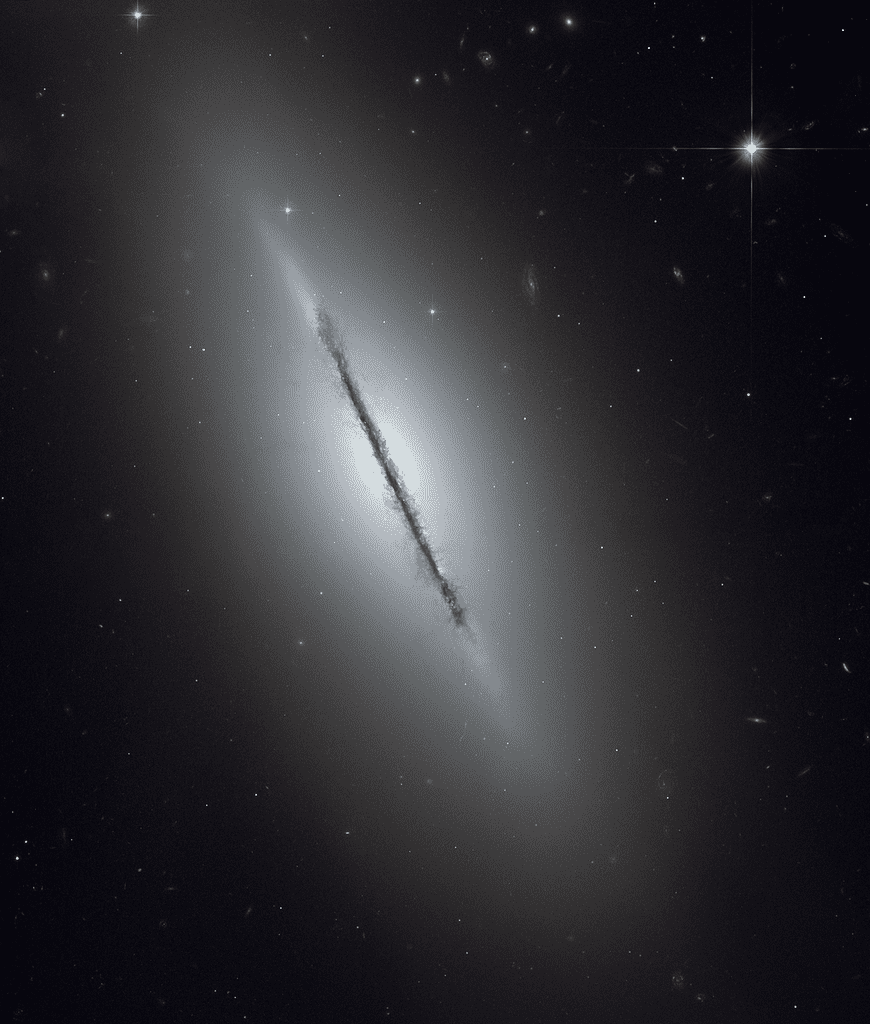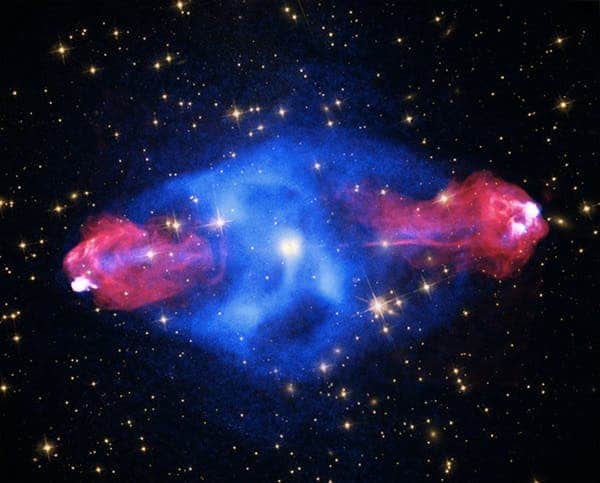Even though we’re only starting to get out of our planetary shell, and exploring the galaxy is nothing more than a pipe dream to us now, we still know quite a bit about the universe around us. For instance, astronomers have found that there are over 200 billion galaxies out there — maybe even way more.
Researchers usually classify these galaxies into categories, and one such category is lenticular, or lens galaxies. Lens galaxies are an intermediate type of galaxy (between spiral and elliptical) and the most common type of galaxy in the universe (or at least, that’s what our current observations tell us). They have a central bulge of stars but lack the spiral arms characteristic of spiral galaxies and yet have a clear disk structure, unlike elliptical galaxies. Despite all this, however, they are perhaps the most poorly understood galaxies.

Galaxies are like the ‘cities’ of stars, collections of gas and dust and billions of solar systems in a single, stable system. Galaxies form stars from dust through the process of accretion, in which more and more dust is clumped together until it becomes a proto-star. That’s why galaxies are so visible in the night sky and especially with telescopes: because of the light that comes from all their stars.
Modern astronomy provides beautiful images of galaxies in our part of the universe, but the main goal of these observations is not aesthetic — it’s scientific. Thanks to such observations, for instance, we know that some of these galaxies form ‘arms’ and others don’t, some have supermassive black holes at the centers and others are so small that a bigger neighbor swallows them.
But observing the universe is one thing, and understanding why it looks the way it does is another. The challenge is to understand the processes that make galaxies different from one another. One complicated puzzle is how some galaxies seem to be somewhere between spiral and elliptical – the so-called lenticular galaxies. But are they exactly that, a transition between the other two main types?
A parade of galaxies
First, let’s understand what a galaxy is. Galaxies are some of the most impactful objects in the universe, consisting of dark matter and stars and planets that orbit those stars — along with other smaller things like dust or asteroids. But galaxies aren’t all the same, they differ in their composition, shape, and age; some have younger stars, and others have older stars each with their own peculiarities.
There are three main types of galaxies:
- elliptical galaxies;
- lenticular galaxies;
- and spiral galaxies.
There’s also another type of galaxy called irregular, which basically means ‘none of the above’ — all the galaxies that researchers can’t classify by normal means, they put into that category.
Edwin Hubble came up with this classification in the 1920s and it is still used to this day. It is represented in a fork-shaped diagram in which the center has the lenticular galaxies.

They also have intermediate classifications. For instance, a perfectly circular image will be called an E0 galaxy, while a flatter object might be an E7 galaxy. Meanwhile, an S0 galaxy is a lenticular galaxy, while spiral galaxies branch into two different categories, as shown above.
Spiral galaxies have dust and young stars that are mostly concentrated at the arms. You can think of spirals as the “trendy” type of galaxy, the modern galaxy that’s doing all the cool things of this age. Meanwhile, elliptical galaxies have a lot of old and heavy stars, with less dust than spirals, but they’re still trying their best to look as cool and young as their sisters.
Irregular galaxies are a whole different beast, they are a result of the chaotic arrangement of material and stars. The disorganized sibling of the other galaxies — the outcast, the misfit. We won’t get into them here, although they’re extremely interesting themselves.
Lenticular galaxies
The distinctive characteristic of some galaxies is the spiral arms — and we have a pretty good idea how they got these arms.
Most things in the universe spin. Planets spin, stars spin, and galaxies also spin. Spirals form due to gravitational instabilities (a density wave, according to some theories). Basically, large-scale structures within the galaxy (or the galaxy itself) may become unstable and collapse, which causes huge masses of gas and dust to eject outwards. As the galaxy spins, these ejected arms are also pulled with the galaxy and become spirals.
Elliptical galaxies, meanwhile, have older stars and generally don’t have a rich star formation environment. They probably formed after collisions between spiral galaxies in galaxy clusters. They look like a pancake of stars, flat, without complex forms.
Lenticular galaxies look half-spiral and half-elliptical; many of them resemble flying saucers. They do have central disks, but no arms. Edwin Hubble believed there was some sort of evolution from spiral to elliptical, maybe lenticulars were between, but modern observations proved otherwise.

Studies showed that lenticular galaxies are the most commonly found in the nearby universe. Like other galaxies, their mass and birthplace are decisive in determining their shape. When two galaxies of nearly the same shape collide, it is called a major merger event, and it can be one of the ways to form a lenticular galaxy which leads to a gas-rich galaxy.
Lenticular galaxies can also form from spirals that used all their dust and gas to form stars. It is possible to find much older stars at the centers compared to the stars formed from dust expulsion.
There are three types of lenticular galaxies, S01, S02, and S03. S01 with no dust and S03 with some remaining dust. However, the classification doesn’t seem significant – the S0 are very similar to each other.
It is difficult to conclude how they came to be, a problem yet to be solved. More observation means more knowledge but also can bring surprising exceptions that make it even harder to explain the formation of a lenticular galaxy.
There are too many elliptical galaxies to even start discussing it, but here are a couple of them that have been studied in detail.
NGC 3115
A mystery to astronomers, NGC 3115 has none of the characteristics described so far, it is rather isolated compared to other lenticular galaxies. In its center lies a supermassive black hole 2 billion times the mass of the Sun.

This supermassive black hole is the closest to Earth, but no worries, it is 32 million light-years from here. X-ray images showed the movement of stars near the center of NGC 3115. In a dance of death, the brightness of the image witnesses the loss of gas from binary star systems too close to the black hole.
Cartwheel Galaxy
Perhaps the most famous of the S0 galaxies is the Cartwheel Galaxy — even more famous now with astonishing James Webb imaging. The similarity to a cartwheel delights most people, but puzzles astronomers. How could it be shaped in such a complex form?
It is believed, the galaxy is a good example of a former spiral that collided with a companion and ended up in the lenticular classification. The two rings are a result of such a collision, they are a remnant of the merging process left as ripples of water. It will continue evolving into something else, another mystery to solve.

Cygnus A

Cygnus A is a radio galaxy, a galaxy that emits strong bursts of radio emissions due to its active galactic nucleus (radio galaxies can be either lenticular or spiral, though the majority are lenticular). Cygnus A is powered by a supermassive black hole in the center of the galaxy that is about a billion times more massive than the Sun, surrounded by a disk of hot gas that emits the radio signal.
This makes Cygnus A one of the brightest things in the night sky (in the radio frequency).
The bottom line
Lenticular (or S0) galaxies are very common throughout the universe, but they’re still not fully understood. Recent advances were crucial to getting to the knowledge we have so far. Perhaps, the James Webb Space Telescope is a hope of cataloging more and more galaxies to understand their formation.






